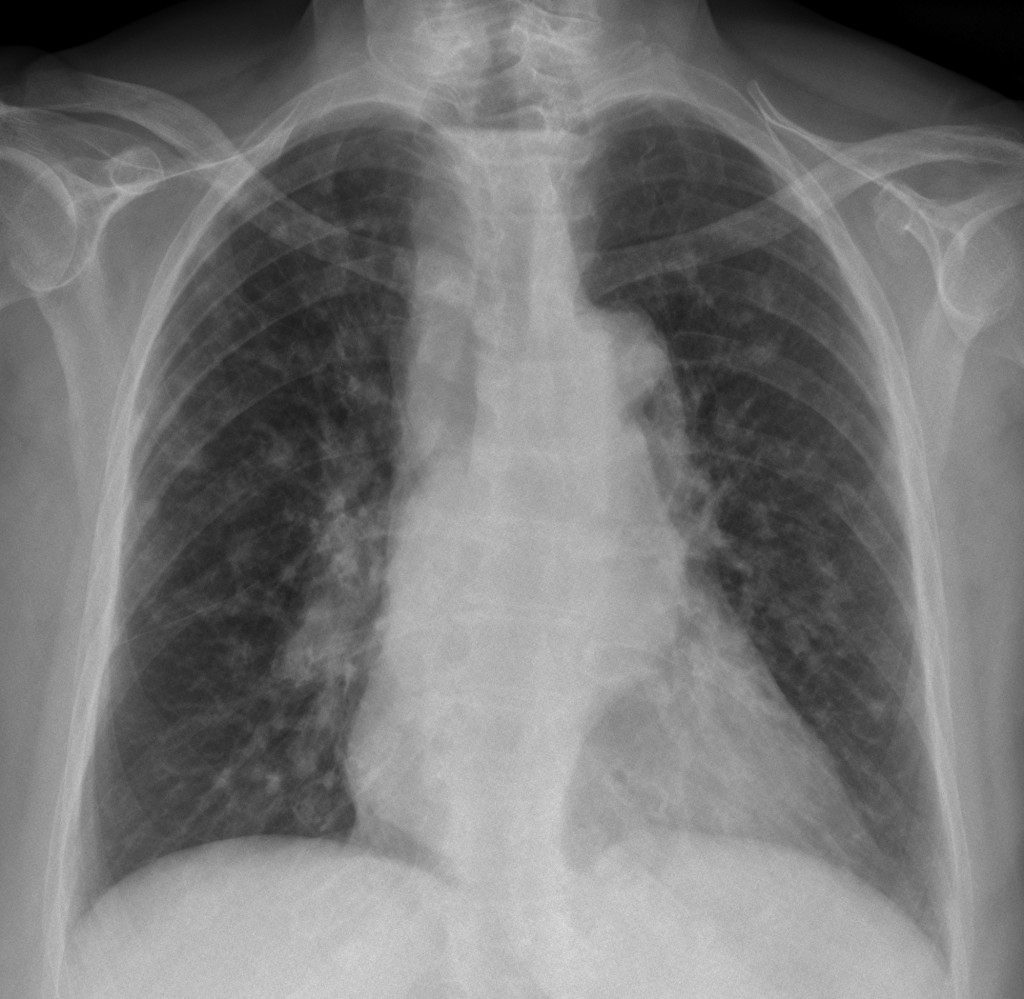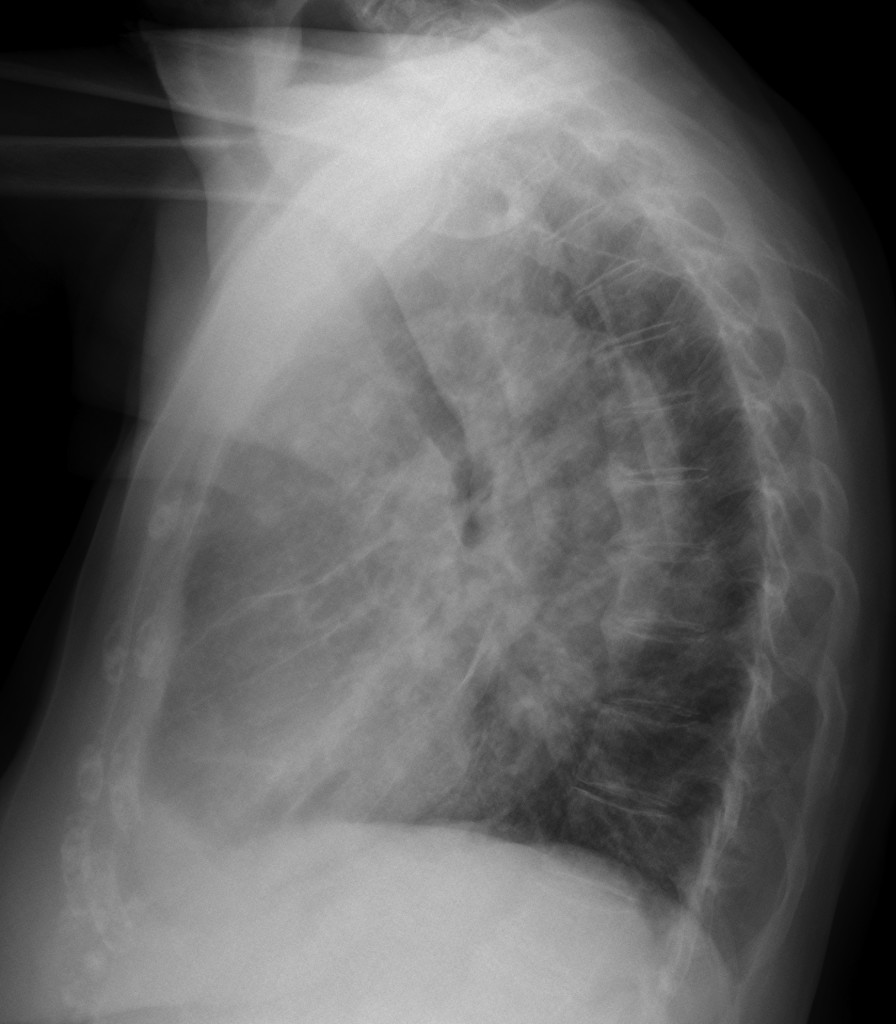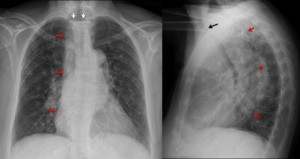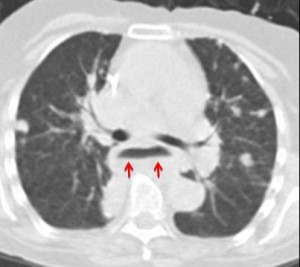
Dear Friends,
In the best Christmas spirit, Muppet is presenting a nice case. These radiographs belong to an 86-year-old lady who came to the emergency room with chest pain. Pulmonary nodules were visible. What would be your diagnosis?

PA chest, 86-year-old woman

lateral chest, 86-year-old woman
1. Metastases
2. Granulomas
3. Bronchioalveolar carcinoma
4. Lymphoma
Leave your comments below and look out for the answer next week.
Click here for the answer to Case 47
Findings: PA chest radiograph shows an air-fluid level in the upper mediastinum (arrows). There is widening of the right mediastinum (red arrows). On the lateral view there is forward displacement of the trachea (arrow) with occupation of the whole middle mediastinum (red arrows).
The findings are highly suggestive of a dilated esophagus. In addition, pulmonary nodules can be seen. CT confirms the marked dilatation of the esophagus (arrows) and the pulmonary nodules. This combination suggests two possible etiologies: carcinoma of the distal esophagus with metastases or achalasia with aspiration. In this particular case, the pulmonary lesions did not change for two years, which points to post-aspiration granulomas.


Final diagnosis: achalasia (surgically proven) with pulmonary aspiration, possible atypical TB granulomas (unproven).
Teaching point: this case completes the gamut of air-fluid levels in the chest: mediastinum, pleural space and pulmonary cavities. They are easy to recognize during imaging in the plain film and help to plan the right diagnostic approach.
Muppet wishes very happy holidays to all of you!







Multiple bilateral randomly distributed dense nodules and mediastinal- hilar adenopathies.
There is a cervical air-fluid level related with a mass effect which desplaces anteriorly the trachea. First I thought it could be a Zenker diverticulum, but it seems to continue with the enlarged mediastinum, so it might be the esophagus itself.
I would initially think of pulmonary mets from an esophageal neoplasm.
Il radiogramma in AP e LL fa vedere il “famoso” livello idro-aereo alla base del collo, con opacità di massa , omogeneamente opaca, che sospinge in avanti la trachea e la impronta posteriormente.La dislocazione della trachea continua a livello intra-toracico ove si osserva la scomparsa dello spazio chiaro retrosternale, sempre per una massa “bulging.like”. Opacità micronodulari, sfumate, in entrambi i campi polmonari.La sede del livello idro-aereo è l’esofago cervicale, ma la causa del livello mi sembra estrinseca , come di natura adenopatica.La prima ipotesi è per linfoma, ma vorrei sapere lo stato delle mammelle che non si vedono bene( in involuzione sclero-atrofica senile-Mastectomia?In questultimo caso cambierebbe la diagnosi in metastasi e linfangite carcinomatosa polmonare).
No breast surgery. Since I like you ( Dr. Pepe does too) will add some information: nodules were present and unchanged in a previous study, taken one year earlier
Merry Christmas Dr. Pepe and family.
Nodules seem very dense. Some might contain calcifications. I’ll go with granulomas, specially after Dr. Cáceres’ clues.
The cervical mass can be a Zenker diverticulum.
Additional information helped, my choice is definitely granulomas, otherwise I would say lymphoma.
Thank you and Happy New Year.
Can you tie the granulomas with the mediastinal changes?
There is diffuse esophageal dilatation and pulmonary nodules. Albert´s diagnosis (esophageal cancer and mets) sounds good. But now we know that pulmonary nodules have been stable for one year. There is another tip by muppet from a previous case:
“Muppet offers additional information: in achalasia, oesophageal contents may be colonised by nontuberculous Mycobacteria. In a patient with achalasia with chronic pulmonary infiltrates think of infection by nontuberculous Mycobacteria.”
So, I also choose granulomas.
Good. You are in your way to earning a T-shirt!
Grazie per tutte le informazioni dei colleghi e dell’illustre Professore….Se c’è acalasia esofagea, questa comporta come complicanza infettiva, quella di saprofiti dell’esofago: moniliasi e candidosi.La virulentazione di questi saprofiti, determina sovrainfezione polmonare , con aspetto ” granulomatoso”.Poichè l ‘acalasia è una condizione cronica, questo spiega la “cronicità” dei granulomi fungini a livello polmonare.
Although Clinically there is no constitutional symptoms such as productive cough,fever and weight loss typical for tuberculosis.bilateral nodular opacities ,hilar adenopathy.still will go for granuloma.
Dr. Caceres:
Still enjoying your cases and encouraging the residents at the hospital where I lecture to log in to your web site.
I have been unable to find much on aspiration-related granuloma formation (ie, other than aspiration secondary to bacteria,fungi, etc.) If you have any reference, I would greatly appreciate it.
With continued appreciation for the teaching cases,
Herb Kaufman